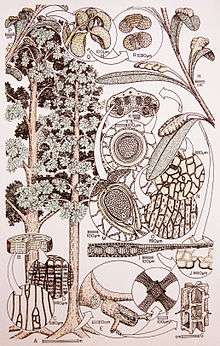Dictyopteridium
| Dictyopteridium Temporal range: Late Permian | |
|---|---|
 | |
| Reconstruction of the glossopterid plant Dictyopteridium sporiferum, with Glossopteris communis leaves, Eretmonia hinjridaensis pollen organ, Protohaploxypinus limpidus pollen, Ararucarioxylon bengalense wood and chambered roots of Vertebraria australis from Late Permian Blackwater Coal Measures near Homevale Station, Queesnland[1] | |
| Scientific classification | |
| Kingdom: | Plantae |
| Division: | †Pteridospermatophyta |
| Order: | †Glossopteridales |
| Family: | †Glossopteridaceae |
| Genus: | †Dictyopteridium Feistmantel 1881 |
| Species | |
| |
Dictyopteridium is an extinct genus of plants belonging to Glossopteridaceae, but the name is used only for compression fossils of elongate multiovulate reproductive structures adnate to Glossopteris leaves.[2] Permineralized remains identical to Dictyopteridium have been referred to the organ genus Homevaleia[3]




Description
Dictyopteridium is an elongate leaf like structure adnate to the upper surface of ordinary-appearing leaves of Glossopteris. It bore numerous ovules on its lower side which was folded over and filled with mucilage cells. Pollen still found its way into the pollen chambers of these protected seeds, and fertilization was by means of motile sperm with helical cilial bands.
Whole plant associations
Permineralzed remains from the Late Permian Blackwater Coal Measures near Homevale Station, Queesnland are evidence that the following paleobotanical organ genera were part of the same plant species: Dictyopteridium sporiferum impression of ovulate structure, Homevaleia gouldii permineralized ovuulate structure, Glossopteris communis impressions of leaves, Eretmonia hinjridaensis pollen organ, Protohaploxypinus limpidus pollen, Araucarioxylon bengalense wood, and Vertebraria australis chambered roots.
References
- ↑ Retallack, G.J.; Dilcher, D.L. (1988). "Reconstructions of selected seed ferns". Missouri Botanical Garden Annals. 75: 1010–1057. doi:10.2307/2399379.
- ↑ Taylor, Edith L.; Taylor, Thomas N.; Krings, Michael (2009). Paleobotany: The Biology and Evolution of Fossil Plants. Academic Press. pp. 271–74. ISBN 9780080557830.
- ↑ Nishida, H.; Pigg, K.B.; Kudo. K. & Rigby, J.F. (2007). "New evidence of reproductive organs of Glossopteris based on permineralized fossils from Queensland, Australia. I. Ovulate organ Homevaleia gen. nov.". Journal of Plant Research. 120: 539–549. doi:10.1007/s10265-007-0093-0.